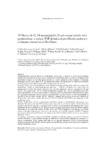15-Deoxy-Δ-12, 14-prostaglandin J2 acts cooperatively with prednisolone to reduce TGF-β-induced pro-fibrotic pathways in human osteoarthritis fibroblasts

Ver/
Use este enlace para citar
http://hdl.handle.net/2183/28708
A non ser que se indique outra cousa, a licenza do ítem descríbese como Creative Commons Attribution-NonCommercial-NoDerivs 4.0 International License (CC-BY-NC-ND 4.0)
Coleccións
- Investigación (FCS) [1293]
Metadatos
Mostrar o rexistro completo do ítemTítulo
15-Deoxy-Δ-12, 14-prostaglandin J2 acts cooperatively with prednisolone to reduce TGF-β-induced pro-fibrotic pathways in human osteoarthritis fibroblastsAutor(es)
Data
2019-03-29Cita bibliográfica
Vaamonde-Garcia C, Malaise O, Charlier E, Deroyer C, Neuville S, Gillet P, Kurth W, Meijide-Failde R, Malaise MG, de Seny D. 15-Deoxy-Δ-12, 14-prostaglandin J2 acts cooperatively with prednisolone to reduce TGF-β-induced pro-fibrotic pathways in human osteoarthritis fibroblasts. Biochem Pharmacol. 2019 Jul;165:66-78.
Resumo
[Abstract] Abstract
Background/aims: Synovial fibrosis is a pathological process that is observed in several musculoskeletal disorders and characterized by the excessive deposition of extracellular matrix, as well as cell migration and proliferation. Despite the fact that glucocorticoids are widely employed in the treatment of rheumatic pathologies such as osteoarthritis (OA) and rheumatoid arthritis, the mechanisms by which glucocorticoids act in the joint and their impacts on pro-fibrotic pathways are still unclear.
Materials: Human OA synovial fibroblasts were obtained from knee and hip joints. Cells were treated with prednisolone (1 mM) or transforming growth factor-beta 1 (TGF-β1) (10 ng/ml) for 1 and 7 days for quantification of RNA and protein expression (by real-time quantitative reverse transcription-PCR and western blot, respectively), 72 h for immunocytochemistry analysis, and 48 h for proliferation (by BrdU assay) and migration (by wound assay) studies. In addition, cells were preincubated with prednisolone and/or the peroxisome proliferator-activated receptor gamma (PPAR-γ) agonist 15-deoxy-Δ-12,14-prostaglandin J2 (15d-PGJ2) for 6 h before adding TGF-β1. pSmad1/5, pSmad2 and β-catenin levels were analyzed by Western blot. The activin receptor-like kinase-5 (ALK-5) inhibitor (SB-431542) was employed for the mechanistic assays.
Results: Prednisolone showed a predominant anti-fibrotic impact on fibroblast-like synoviocytes as it attenuated the spontaneous and TGF-β-induced gene expression of pro-fibrotic markers. Prednisolone also reduced α-sma protein and type III collagen levels, as well as cell proliferation and migration after TGF-β stimulation. However, prednisolone did not downregulate the gene expression of all the pro-fibrotic markers tested and did not restore the reduced PPAR-γ levels after TGF-β stimulation. Interestingly, anti-fibrotic actions of the glucocorticoid were reinforced in the presence of the PPAR-γ agonist 15d-PGJ2. Combined pretreatment modulated Smad2/3 levels and, similar to the ALK-5 inhibitor, blocked β-catenin accumulation elicited by TGF-β.
Conclusions: Prednisolone, along with 15d-PGJ2, modulates pro-fibrotic pathways activated by TGF-β in synovial fibroblasts at least partially through the inhibition of ALK5/Smad2 signaling and subsequent β-catenin accumulation. These findings shed light on the potential therapeutic effects of glucocorticoids treatment combined with a PPAR-γ agonist against synovial fibrosis, although future studies are warranted to further evaluate this concern.
Palabras chave
Fibroblast-like-synoviocytes
Fibrosis
Glucocorticoids
Osteoarthritis
Peroxisome proliferator-activated receptor-γ agonist;
Transforming growth factor-β1
Fibrosis
Glucocorticoids
Osteoarthritis
Peroxisome proliferator-activated receptor-γ agonist;
Transforming growth factor-β1
Versión do editor
Dereitos
Creative Commons Attribution-NonCommercial-NoDerivs 4.0 International License (CC-BY-NC-ND 4.0)
ISSN
0006-2952






